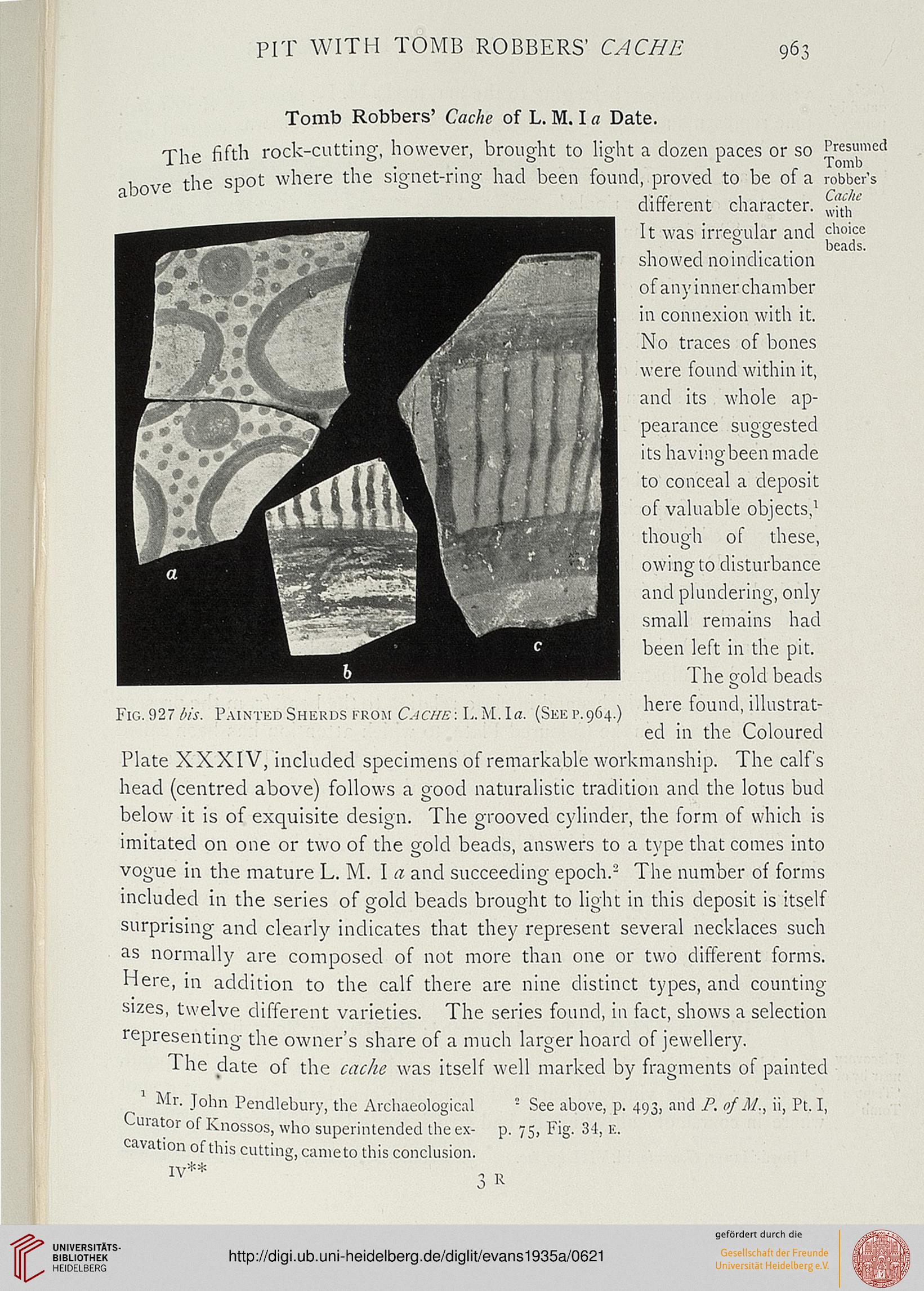PIT WITH TOMB ROBBERS' CACHE
963
Tomb Robbers' Cache of L. M. I a Date.
The fifth rock-cutting, however, brought to light a dozen paces or so Presumed
above
the spot where the signet-ring had been found, proved to be of a robber's
Fig. 927 te. Painted Sherds from Cache: L.M.I a. (SEEP.964.)
different character. w™h"
It was irregular and choice
... . beads.
showed noindicatton
of any inner chamber
in connexion with it.
No traces of bones
were found within it,
and its whole ap-
pearance suggested
its having been made
to conceal a deposit
of valuable objects,1
though of these,
owing to disturbance
and plundering, only
small remains had
been left in the pit.
The gold beads
here found, illustrat-
ed in the Coloured
Plate XXXIV, included specimens of remarkable workmanship. The calf's
head (centred above) follows a good naturalistic tradition and the lotus bud
below it is of exquisite design. The grooved cylinder, the form of which is
imitated on one or two of the gold beads, answers to a type that comes into
vogue in the mature L. M. I a and succeeding epoch.2 The number of forms
included in the series of gold beads brought to light in this deposit is itself
surprising and clearly indicates that they represent several necklaces such
as normally are composed of not more than one or two different forms.
Here, in addition to the calf there are nine distinct types, and counting-
sizes, twelve different varieties. The series found, in fact, shows a selection
representing the owner's share of a much larger hoard of jewellery.
The date of the cache was itself well marked by fragments of painted
Mr. John Pendlebury, the Archaeological ' See above, p. 493, and P. of M., ii, Pt. I,
Curator of Knossos, who superintended the ex- p. 75, Fig. 34, E.
cavation of this cutting, cameto this conclusion.
IV**
963
Tomb Robbers' Cache of L. M. I a Date.
The fifth rock-cutting, however, brought to light a dozen paces or so Presumed
above
the spot where the signet-ring had been found, proved to be of a robber's
Fig. 927 te. Painted Sherds from Cache: L.M.I a. (SEEP.964.)
different character. w™h"
It was irregular and choice
... . beads.
showed noindicatton
of any inner chamber
in connexion with it.
No traces of bones
were found within it,
and its whole ap-
pearance suggested
its having been made
to conceal a deposit
of valuable objects,1
though of these,
owing to disturbance
and plundering, only
small remains had
been left in the pit.
The gold beads
here found, illustrat-
ed in the Coloured
Plate XXXIV, included specimens of remarkable workmanship. The calf's
head (centred above) follows a good naturalistic tradition and the lotus bud
below it is of exquisite design. The grooved cylinder, the form of which is
imitated on one or two of the gold beads, answers to a type that comes into
vogue in the mature L. M. I a and succeeding epoch.2 The number of forms
included in the series of gold beads brought to light in this deposit is itself
surprising and clearly indicates that they represent several necklaces such
as normally are composed of not more than one or two different forms.
Here, in addition to the calf there are nine distinct types, and counting-
sizes, twelve different varieties. The series found, in fact, shows a selection
representing the owner's share of a much larger hoard of jewellery.
The date of the cache was itself well marked by fragments of painted
Mr. John Pendlebury, the Archaeological ' See above, p. 493, and P. of M., ii, Pt. I,
Curator of Knossos, who superintended the ex- p. 75, Fig. 34, E.
cavation of this cutting, cameto this conclusion.
IV**




